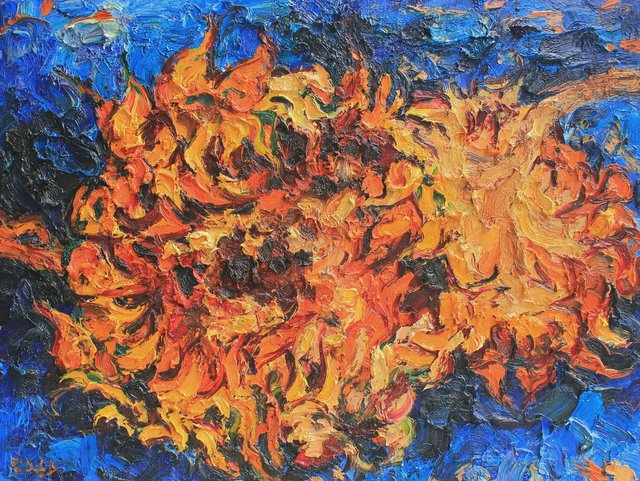"Two Men with Handcart": A Captivating Artwork from India

In the rich tapestry of the art world, “Two Men with Handcart” stands out as a work that encapsulates a moment in time, a cultural essence, and the creative genius of its maker.
The artist behind this masterpiece is Gieve Patel, a remarkable figure in the art scene. Born in 1940 in the vibrant city of Bombay (now Mumbai), India, Patel has spent his life observing and translating the nuances of his surroundings onto the canvas. His gender, male, has perhaps influenced his perspective in ways that are subtly yet powerfully imprinted on his works, bringing a particular gaze that navigates through the social and physical landscapes of his homeland.
The year 1979 marked a significant milestone when Patel, in the very heartland of India, embarked on the journey of creating “Two Men with Handcart”. The physical dimensions of this painting, w144.8 x h176.5 cm, are not just numbers but rather a crucial aspect of its impact. The expansive width and height offer ample space for Patel to weave a complex visual narrative. The broad canvas becomes a stage where every brushstroke, every shade of color, unfolds a story that draws the viewer in, making them almost a part of the scene.
The medium of oil on canvas was Patel’s choice, a decision that bestowed the painting with a unique tactile quality. The oils, with their ability to blend and layer, allowed him to build up textures that mimic the roughness of the handcart, the weariness or determination in the men’s postures, and the atmospheric backdrop of an Indian setting. This tactile richness gives the painting a sense of immediacy, as if one could reach out and touch the very fabric of the depicted world.
Categorized as a painting, it transcends the simple label. It is a portal into Patel’s psyche and the society he was immersed in. The image of the two men with a handcart could be a mundane daily scene, yet Patel’s artistic lens transforms it into a profound exploration of labor, survival, or perhaps the journey of life itself. The figures might symbolize the common man’s struggle, the quiet perseverance in the face of hardships that was prevalent in India during that era.
Today, this artistic gem finds its home in the Peabody Essex Museum. It was acquired in 2003, courtesy of the Chester and Davida Herwitz Collection. This placement in a renowned institution not only safeguards the painting but also elevates its status, making it accessible to a global audience of art lovers, students, and scholars. It serves as a touchstone for understanding Patel’s oeuvre, the evolution of Indian art in the latter half of the 20th century, and the universal themes of human existence that art has always strived to capture. In essence, “Two Men with Handcart” is more than a painting; it is a cultural artifact that continues to resonate and inspire, bridging the gap between a specific moment in India’s past and the timeless realm of art appreciation.




